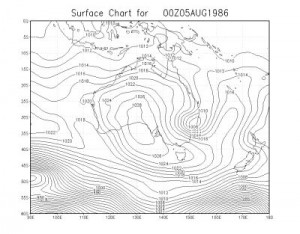 On this day in 1986, Sydney broke its record for a 24 hour period. About 327.8 fell in the city in 24 hours to the 6th August and the western suburbs also received about 254mm of rain which is significant for this region. Parts of Sydney were isolated and many people were not able to get home. Trains were delayed for 5 hours as the Sydney underground tunnels filled with water.
On this day in 1986, Sydney broke its record for a 24 hour period. About 327.8 fell in the city in 24 hours to the 6th August and the western suburbs also received about 254mm of rain which is significant for this region. Parts of Sydney were isolated and many people were not able to get home. Trains were delayed for 5 hours as the Sydney underground tunnels filled with water.
This event was produced by a complex low pressure system.

I remember someone advising me that the event commenced with some thunderstorm activity just prior to the main rain event occurring.
I was not residing in Sydney at the time and was a teenager growing up at Albury so I have no memory of this event. However, I have found some rainfall data to show how significant this event was. Looking at the rainfall data, much of Sydney especially the Greater West had endured a dry spell lasting approximately 6 months from February to August 5 1986. I am wondering whether the rainfall was a catch up on the deficits created during that dry spell.
As shown for Seven Hills, the rainfall for the year 1986 is:-.
January – 153.6 mm. February – 32.8 mm, March – 4.1 mm, April – 34.1 mm, May – 19.5 mm, June 4.8 mm, July 22.4 mm, August 394.2 mm, September – 41.4 mm, October 42.5 mm, November 189.3 mm, December 17.3 mm. The Rainfall for 1986 – 956 mm.
As shown for Prospect, the rainfall for the year 1986 is:-
January – 169.6 mm, February – 28.4 mm, March – 5.8 mm, April – 30.8 mm, May 28.6 mm, June – 3 mm, July 19.4 mm, August 458.5 mm, September – 35.4 mm, October 62.4 mm, November – 180.1 mm, December – 21.6 mm. The Rainfall for 1986 – 1,043.6 mm.
As shown for Penrith (Penrith Lakes), the rainfall for the year 1986 is:-
January – 167.5 mm, February – 41 mm, March – 3.8 mm, April – 43 mm, May – 19.3 mm, June 0.7 mm, July 18.6 mm, August 396.6 mm, September – 56 mm, October – 42.4 mm, November – 188.2 mm, December 13.4 mm. The rainfall for 1986 – 990.5 mm.
As shown for Sydney (Observatory Hill), the rainfall for the year 1986 is:-
January – 202.8 mm, February – 91 mm, March – 15 mm, April – 117.4 mm, May – 50.2 mm, June 11.8 mm, July 27.4 mm, August 470.6 mm, September 30.2 mm, October – 56.6 mm, November – 143.8 mm, December 8.5 mm. The rainfall for 1986 – 1,225.3.
It does suggest that suburbs across Western Sydney away from the coastal strip had endured a 6 month dry spell prior to the event. It could have been a dry winter had it not been for the east coast low event of 5 to 7 August 1986.
Note:- I have obtained the data form the BOM rainfall achives 10/8/2013.
I have looked at rainfall data on a daily basis for a few weather stations. The event commenced on 5 August and mostly concluded on 7 August 1986 except for some lingering shower activity. Some very light showers did linger around for 2 or 3 days after the main event but falls were very light. I have found the following records for this post:-
Sydney 5/8/86 – 88 mm. 6/8/86 – 327.6 mm and 7/8/86 – 32.8 mm.
Prospect 5/8/86 – 87.4 mm. 6/8/86 – 321 mm and 7/8/86 – 32.2 mm.
Seven Hills 5/8/86 – 85 mm. 6/8/86 – 250 mm and 7/8/86 – 38 mm.
Parramatta 5/8/86 – 87.6 mm. 6/8/86 – 293 mm and 7/8/86 – 32.5 mm.
Richmond 5/8/86 – 184 mm. 6/8/86 – 210 mm and 7/8/86 – 42 mm.
Some data suggests strong rains commenced on 5/8/86 but was heavier around NW Sydney such as Richmond. The event peaked on 6/8/86 then eased throughout 7/8/86.
Source – BOM archived daily rainfall data for 1986 (10/8/13).
I am unable to provide statements of weather conditions on the night of 5/8/86 as it would have been interesting. Was there thunderstorm activity? I can only guess based on the data that heavy rain set in on 5/8/86 that lasted all night and throughout 6/8/86. Winds would have increased gradually making the 6 August 1986 a very difficult day for Sydney. The rains would have eased off throughout 7/8/86.